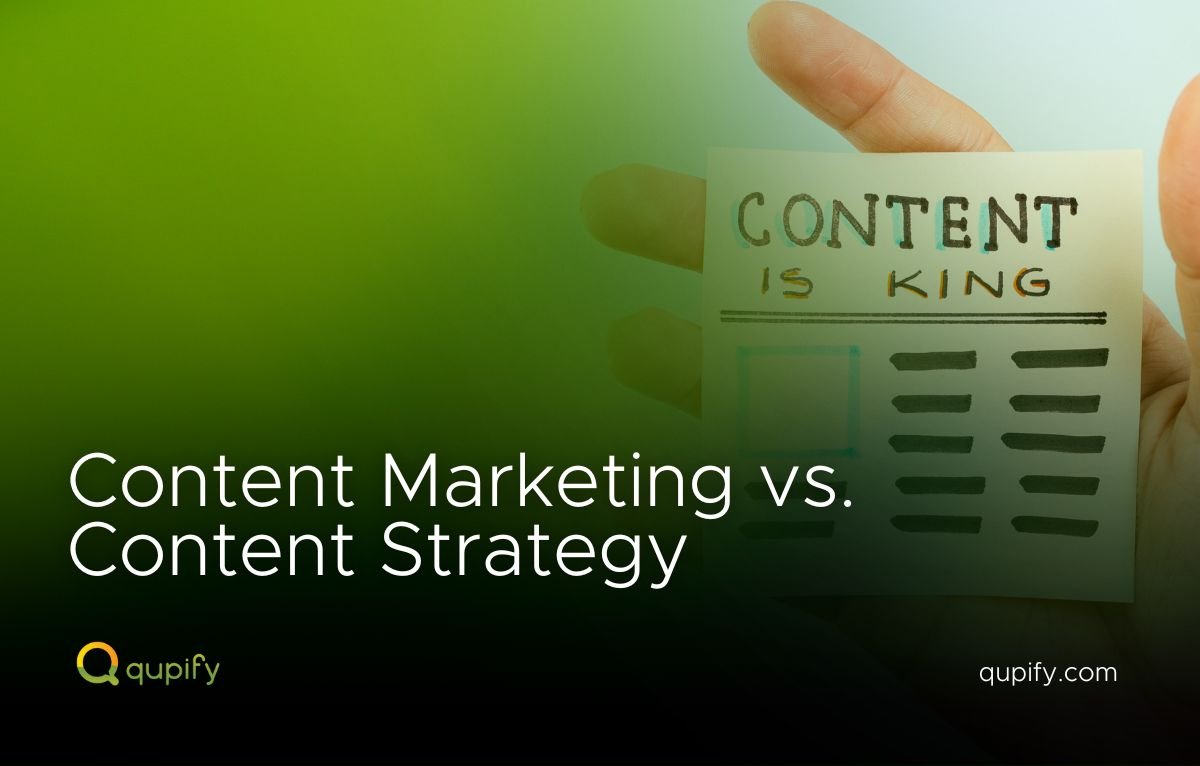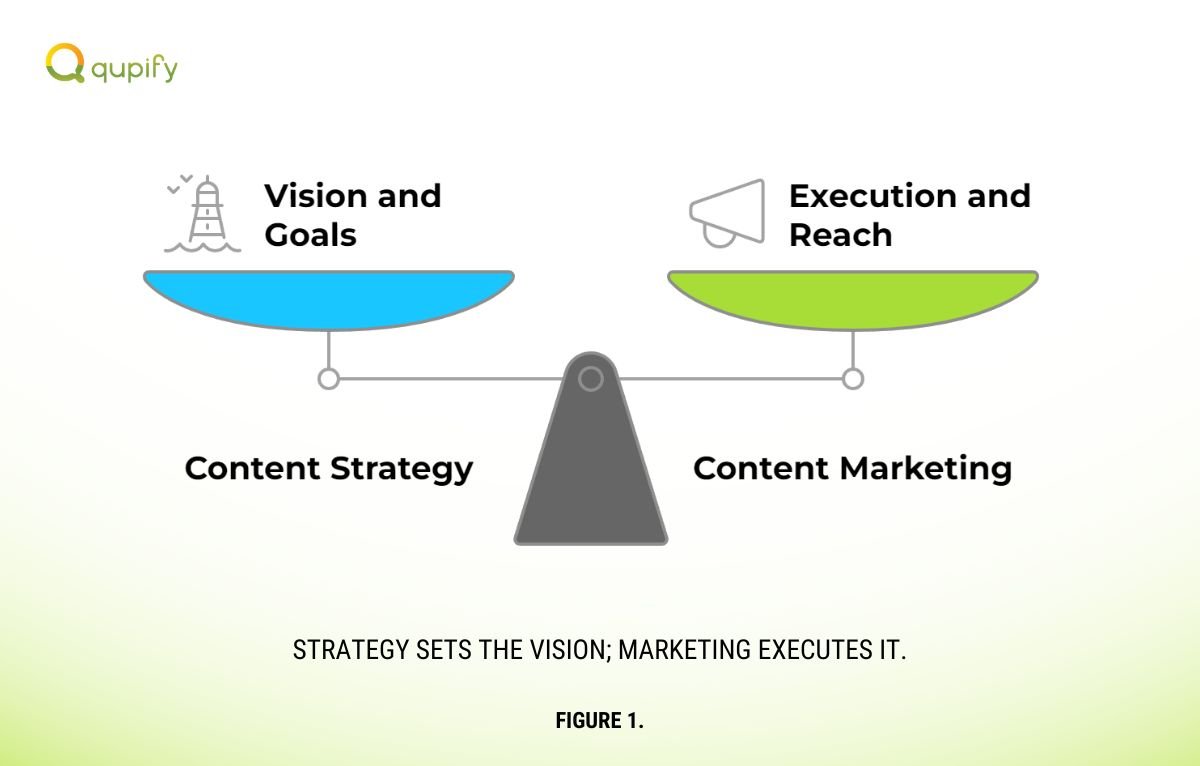Content Marketing vs. Content Strategy
Highlights
- Content marketing focuses on creating and delivering engaging content to connect with the audience
- Content strategy provides the framework, defining goals and guiding content creation and distribution
- Combining both ensures purposeful, impactful content that aligns with long-term business objectives
When it comes to achieving success in digital marketing, content is a core element of every strategy. However, not all content efforts are the same.
Two terms that are often used interchangeably—but shouldn’t be—are content marketing and content strategy. While they are deeply connected, they play distinct roles in how businesses create, distribute, and manage content.
Content marketing focuses on execution—the creation and sharing of engaging, valuable content designed to connect with your audience. On the other hand, content strategy lays the groundwork by defining the purpose and direction of your content efforts.
This article will clarify the differences between the two, explain how they work together, and highlight why your business needs both to thrive.

What is Content Strategy?
Content strategy is the behind-the-scenes framework that guides your content marketing efforts. It’s about defining your objectives, understanding your audience, and deciding the best ways to create, manage, and distribute content.
A well-thought-out strategy ensures that all content aligns with your brand’s goals and remains consistent across platforms.
For example, a tech company might determine through audience research that its target market prefers detailed guides over short social media posts.
The content strategy will then prioritize creating in-depth articles and distributing them on their website or email newsletters. Content strategy provides clarity and direction, ensuring that every piece of content serves a specific purpose.
Differences Between Content Marketing and Content Strategy
Content marketing and content strategy often overlap in conversation, but they have distinct roles in a successful content approach.
While content marketing is about the creation and delivery of content to engage an audience, content strategy focuses on the foundation and purpose behind those efforts.
Recognizing these differences can help businesses use both effectively to achieve their goals.
Here are the key distinctions:
1. Purpose
The purpose of content marketing is tactical—it aims to create and share content that attracts, engages, and converts an audience.
It’s action-oriented and focuses on delivering immediate value, such as increasing brand awareness or driving sales.
In contrast, content strategy is strategic. It defines the long-term purpose of your content and ensures every effort aligns with the overall business objectives, such as building a strong brand identity or nurturing customer relationships over time.
2. Content Focus
Content marketing emphasizes “what” content to create and “how” to distribute it effectively. This includes decisions like the type of blog topics to cover or what social media channels to use.
Content strategy, however, addresses the “why” behind content creation and the “how” it fits into a bigger picture.
It ensures that every piece of content has a clear role in achieving broader goals, such as targeting the right audience segments or communicating key brand messages.
3. Duration
Content marketing is often focused on short-to-medium-term campaigns. These campaigns aim to achieve specific objectives, such as launching a new product, increasing website traffic, or promoting a seasonal offer.
On the other hand, content strategy is long-term. It provides a guiding framework that spans months or years, ensuring content efforts remain consistent and effective over time, regardless of individual campaign cycles.
4. Measurement
The success of content marketing is typically measured through campaign-specific metrics like clicks, shares, engagement rates, and conversions. These metrics help assess how well individual pieces of content are performing.
Content strategy, on the other hand, takes a broader view. It evaluates whether all content efforts, collectively, are helping the business meet its overarching goals, such as improving brand reputation, fostering customer loyalty, or supporting sales growth.

How Content Marketing and Content Strategy Work Together
Content marketing and content strategy are like two pieces of a puzzle: one sets the vision, and the other brings it to life. The strategy acts as a foundation, identifying the goals, audience preferences, and types of content that will resonate most.
Marketing then takes this blueprint and creates the actual content, from blog posts to videos, ensuring they align with the defined goals.
For example, if the strategy highlights the importance of engaging young professionals on LinkedIn, marketing would develop a series of posts or articles tailored to this audience. By working together, strategy and marketing create a cohesive approach that maximizes the impact of your content efforts.
Why You Need Both
Skipping one of these elements can weaken your content efforts. Without a content strategy, your marketing might lack focus, leading to inconsistent or ineffective campaigns. Similarly, a strategy without execution is just an idea that doesn’t reach your audience.
When you combine both, you ensure that every piece of content has a clear purpose and fits into your broader business goals. A solid strategy gives direction, while marketing makes those ideas actionable and impactful. Together, they drive meaningful results.
Best Practices for Balancing Content Marketing and Content Strategy
To achieve the best results, it’s essential to balance both strategy and marketing effectively. Start by building a clear content strategy that outlines your goals, audience insights, and key platforms for distribution.
Use this strategy as a guide to plan and execute your marketing campaigns.
Utilize a content calendar to ensure consistency and keep track of your efforts. Regularly measure performance, not just for individual campaigns but also for how well your content aligns with your long-term strategy. Adjust based on analytics and audience feedback to stay effective.
Explore more tips for balancing your content efforts here.
Conclusion
Content marketing and content strategy are both vital for a successful digital presence. While marketing focuses on creating and sharing content, the strategy ensures that every effort has a clear purpose and aligns with your brand’s goals.
Together, they form a powerful duo that helps you connect with your audience, drive engagement, and achieve meaningful business results. Evaluate your current efforts and ensure you’re leveraging both elements effectively to build a content approach that delivers real value and long-term success.



